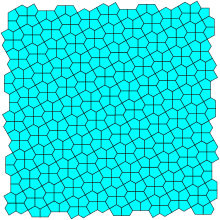Cairo pentagonal tiling
| Cairo pentagonal tiling | |
|---|---|
 |
|
| Type | Dual semiregular tiling |
| Faces | irregular pentagons |
| Coxeter diagram |
|
| Symmetry group |
p4g, [4+,4], (4*2) p4, [4,4]+, (442) |
| Rotation group | p4, [4,4]+, (442) |
| Dual polyhedron | Snub square tiling |
| Face configuration | V3.3.4.3.4 |
| Properties | face-transitive |
In geometry, the Cairo pentagonal tiling is a dual semiregular tiling of the Euclidean plane. It is given its name because several streets in Cairo are paved in this design. It is one of 15 known monohedral pentagon tilings.
It is also called MacMahon's net after Percy Alexander MacMahon and his 1921 publication New Mathematical Pastimes.
Conway calls it a 4-fold pentille.
As a 2-dimensional crystal net, it shares a special feature with the honeycomb net. Both nets are examples of standard realization, the notion introduced by M. Kotani and T. Sunada for general crystal nets.
These are not regular pentagons: their sides are not equal (they have four long ones and one short one in the ratio 1:sqrt(3)-1), and their angles in sequence are 120°, 120°, 90°, 120°, 90°. It is represented by with face configuration V3.3.4.3.4.
It is similar to the prismatic pentagonal tiling with face configuration V3.3.3.4.4, which has its right angles adjacent to each other.
The Cairo pentagonal tiling has two lower symmetry forms given as monohedral pentagonal tilings types 4 and 8:
It is the dual of the snub square tiling, made of two squares and three equilateral triangles around each vertex.
This tiling can be seen as the union of two perpendicular hexagonal tilings, flattened by a ratio of . Each hexagon is divided into four pentagons. The two hexagons can also be distorted to be concave, leading to concave pentagons. Alternately one of the hexagonal tilings can remain regular, and the second one stretched and flattened by in each direction, intersecting into 2 forms of pentagons.
...
Wikipedia

